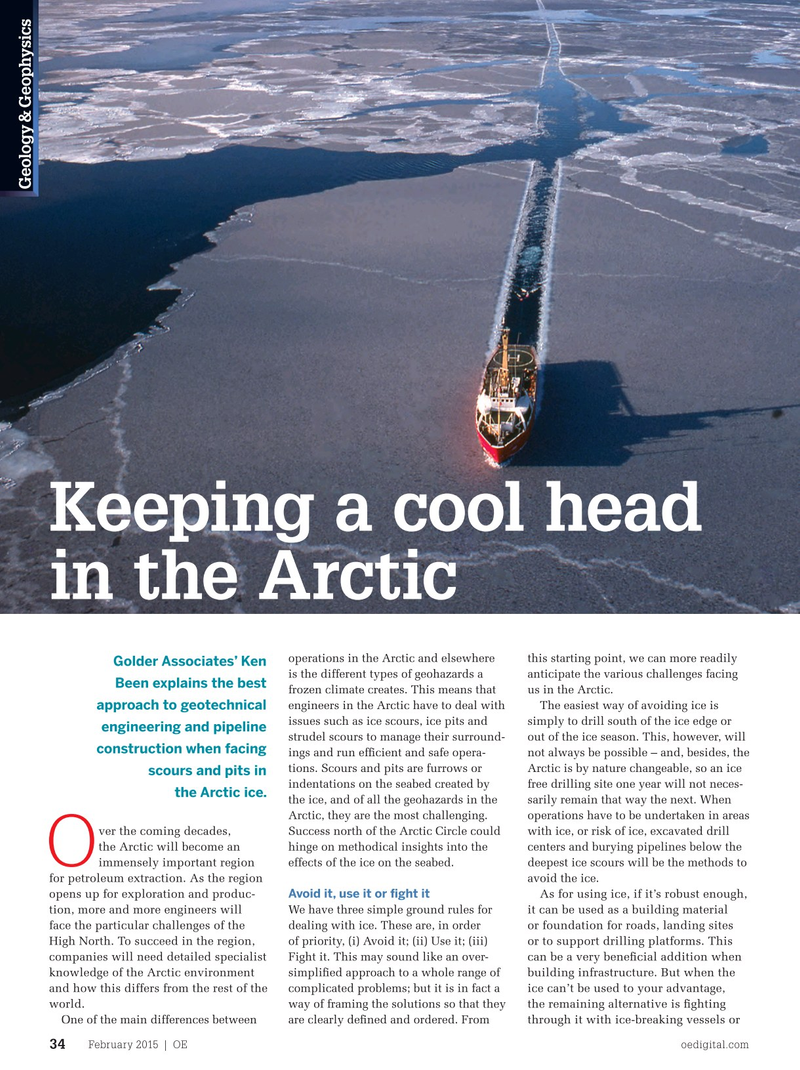
Page 32: of Offshore Engineer Magazine (Feb/Mar 2015)
Read this page in Pdf, Flash or Html5 edition of Feb/Mar 2015 Offshore Engineer Magazine
Geology & Geophysics
Keeping a cool head in the Arctic
Marine seismic data gathering in Arctic waters. Images from Golder Associates.
operations in the Arctic and elsewhere this starting point, we can more readily
Golder Associates’ Ken platforms that can resist the force of the is the different types of geohazards a anticipate the various challenges facing
Been explains the best surrounding ice. frozen climate creates. This means that us in the Arctic. engineers in the Arctic have to deal with The easiest way of avoiding ice is approach to geotechnical
Ice scours and ice pits issues such as ice scours, ice pits and simply to drill south of the ice edge or engineering and pipeline
Pipelines, however, can’t readily strudel scours to manage their surround- out of the ice season. This, however, will construction when facing resist the forces of the ice, as they are ings and run effcient and safe opera- not always be possible – and, besides, the vulnerable to any external impact. tions. Scours and pits are furrows or Arctic is by nature changeable, so an ice scours and pits in
Even if today’s pipelines are designed indentations on the seabed created by free drilling site one year will not neces- the Arctic ice.
to have some plasticity, they can only the ice, and of all the geohazards in the sarily remain that way the next. When handle a limited amount of strain. They
Arctic, they are the most challenging. operations have to be undertaken in areas ver the coming decades, will therefore have to be buried deep
Success north of the Arctic Circle could with ice, or risk of ice, excavated drill the Arctic will become an enough that they are shielded from hinge on methodical insights into the centers and burying pipelines below the
O immensely important region any contact with ice. Because deeper effects of the ice on the seabed. deepest ice scours will be the methods to for petroleum extraction. As the region pipelines mean signifcant added costs, avoid the ice.
Avoid it, use it or fght it As for using ice, if it’s robust enough, however, research into optimal pipe- opens up for exploration and produc-
We have three simple ground rules for it can be used as a building material line depths is a key priority for many tion, more and more engineers will dealing with ice. These are, in order or foundation for roads, landing sites operators.
face the particular challenges of the of priority, (i) Avoid it; (ii) Use it; (iii) The main danger for pipelines is ice
High North. To succeed in the region, or to support drilling platforms. This
Fight it. This may sound like an over- scours, which are grooves in the seabed companies will need detailed specialist can be a very benefcial addition when simplifed approach to a whole range of created by masses of ice that drift across knowledge of the Arctic environment building infrastructure. But when the and how this differs from the rest of the complicated problems; but it is in fact a shallow water (Figure 1). The scours ice can’t be used to your advantage, world. way of framing the solutions so that they are roughly linear and often not deeper the remaining alternative is fghting are clearly defned and ordered. From One of the main differences between than about a meter, but scours up to four through it with ice-breaking vessels or
February 2015 | OE oedigital.com 34 034_0215OE_G&G1_Golder.indd 34 1/20/15 6:16 PM

 31
31

 33
33